warning light MERCEDES-BENZ GL SUV 2012 User Guide
[x] Cancel search | Manufacturer: MERCEDES-BENZ, Model Year: 2012, Model line: GL SUV, Model: MERCEDES-BENZ GL SUV 2012Pages: 441, PDF Size: 10.66 MB
Page 51 of 441
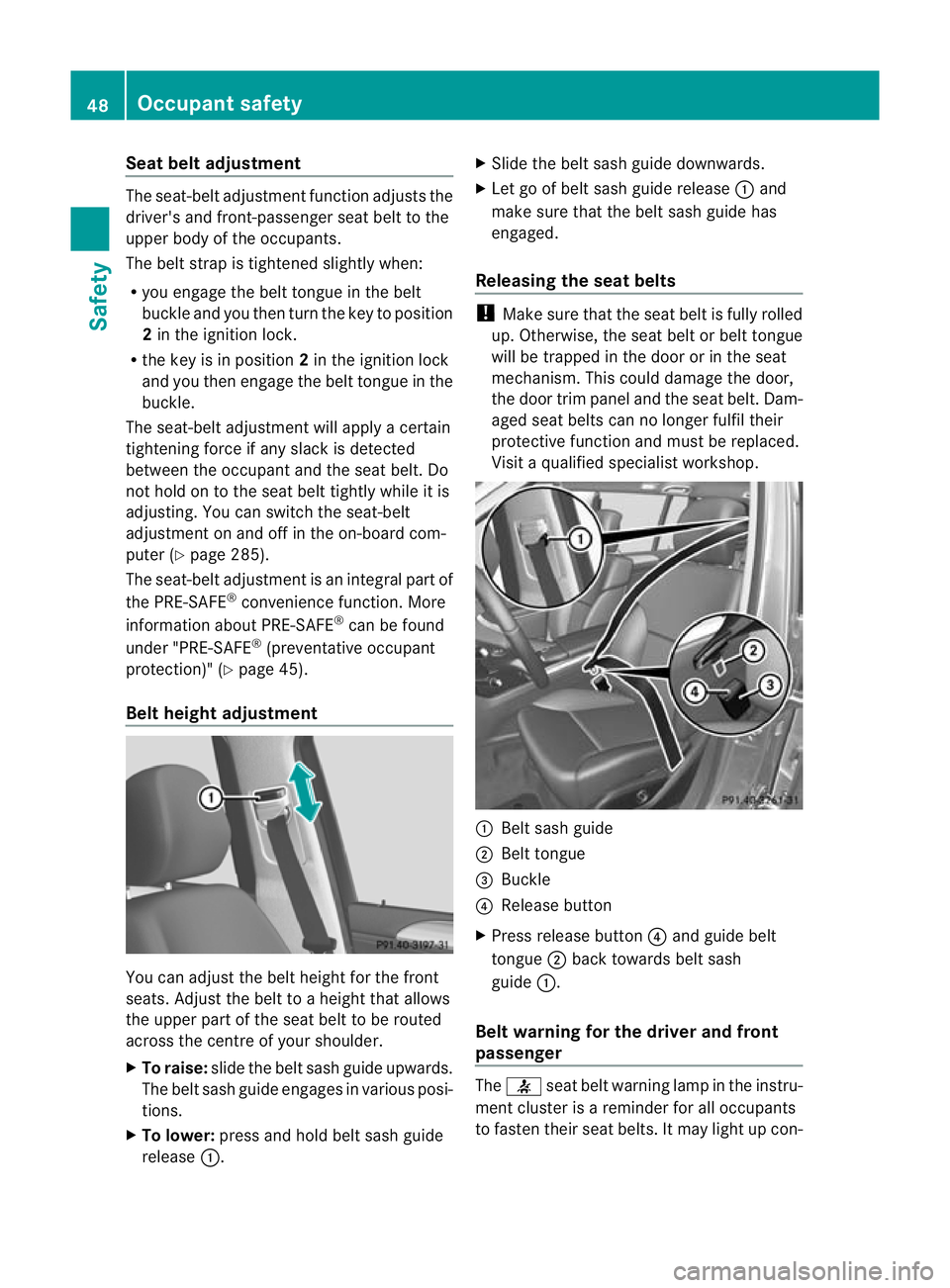
Sea
tbelt adjustment The seat-belt adjustment func
tion adjusts the
driver's and front-passenger seat belt to the
upper body of the occupants.
The belt strap is tighte neds lightly when:
R you engage the belt tongue in the belt
buckle and you then turn the key to position
2in the ignition lock.
R the key is in position 2in the ignition lock
and you then engage the belt tongue in the
buckle.
The seat-belt adjustment will apply acertain
tightening force if any slack is detected
between the occupant and the seat belt. Do
not hold on to the seat belt tightly while it is
adjusting. You can switch the seat-belt
adjustmen tonand off in the on-board com-
puter (Y page285).
Th es eat-belt adjustmen tisani ntegral part of
the PRE-SAFE ®
convenience function. More
information abou tPRE-SAFE ®
can be found
under "PRE-SAFE ®
(preventative occupant
protection)" (Y page 45).
Belt height adjustment You can adjust the belt height for the front
seats
.Adjust the belt to aheight that allows
the upper part of the seat belt to be routed
across the centre of your shoulder.
X To raise: slide the belt sash guide upwards.
The belt sash guide engages in various posi-
tions.
X To lower: press and hold belt sash guide
release :. X
Slide the belt sash guide downwards.
X Let go of belt sash guide release :and
mak esure that the belt sash guide has
engaged.
Releasing the seat belts !
Make sure that the seat belt is fully rolled
up. Otherwise, the seat belt or belt tongue
will be trapped in the door or in the seat
mechanism. This could damage the door,
the door trim panel and the seat belt. Dam-
aged seat belts can no longer fulfil their
protective function and must be replaced.
Visit aqualified specialist workshop. :
Belt sash guide
; Belt tongue
= Buckle
? Release button
X Press release button ?and guide belt
tongue ;back towards belt sash
guide :.
Belt warning for the driver and front
passenger The
7 seat belt warning lamp in the instru-
ment cluster is areminder for all occupants
to fasten their seat belts. It may light up con- 48
Occupant safetySafety
Page 52 of 441
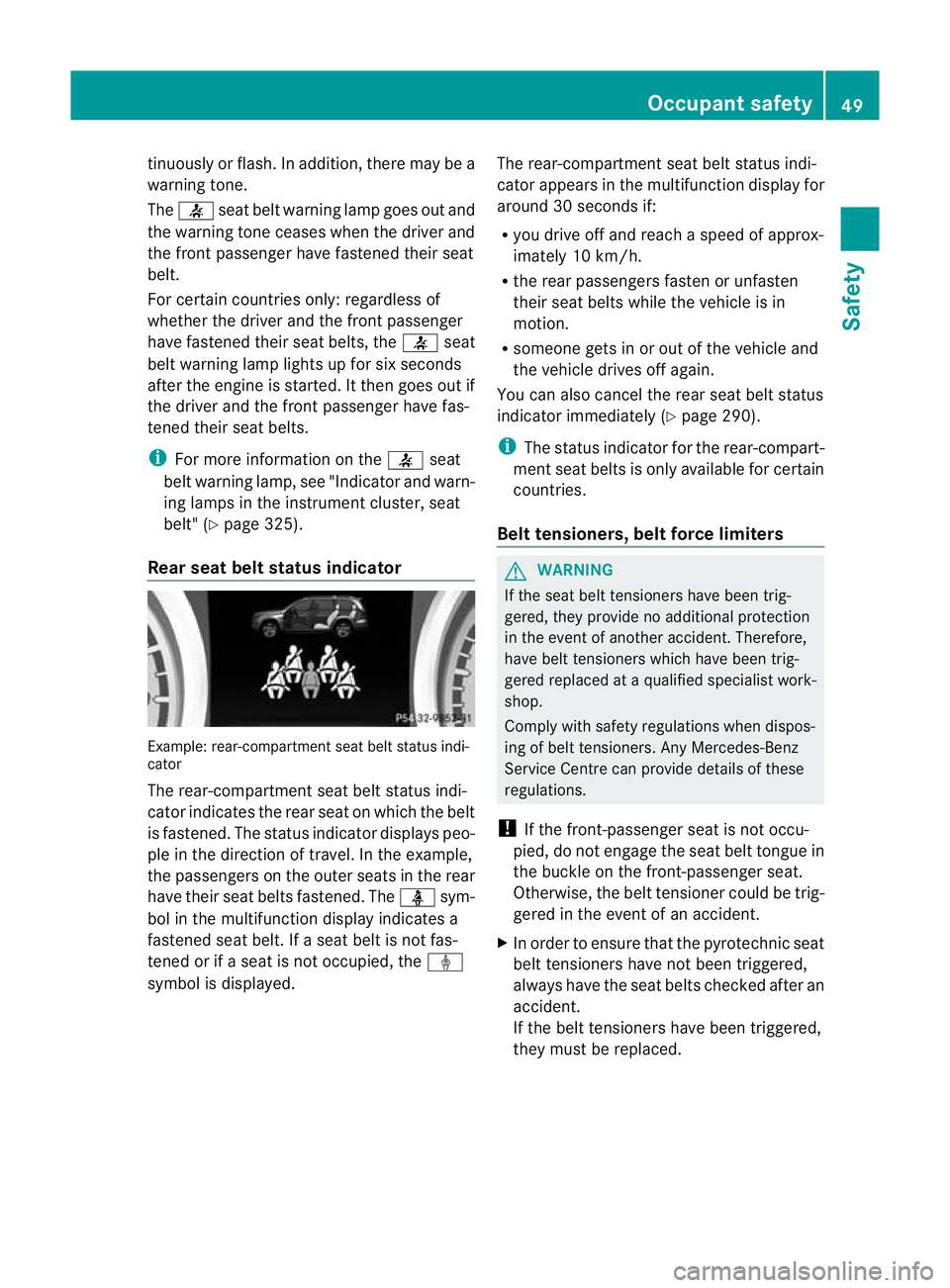
tinuousl
yorflash. In addition, th erem ay be a
warning tone.
The 7 seat belt warning lamp goes ou tand
the warning tone ceases when the driver and
the front pass enger hav efastened their seat
belt.
For certain coun tries only: regardless of
whether th edriver and the front passenger
have fastened their seat belts, the 7seat
bel tw arning lamp lights up for six seconds
after the engin eisstarted. It then goes out if
th ed river and the front passenger have fas-
tened thei rseat belts.
i For mor einformation on the 7seat
bel twarning lamp, see "Indicator and warn-
in gl am ps in the instrument cluster ,seat
belt" (Y page 325).
Rear seat belt status indicator Example: rear-compartment sea
tbelts tatus indi-
cator
The rear-comp artment sea tbelt status indi-
cator indicates the rear seat on which the belt
is fastened. The status indicator displays peo-
ple in the direc tion of travel. In the example,
the passenger sonthe outer seats in the rear
hav etheir seat belts fastened. The üsym-
bol in the multifunction displa yindicates a
fastened sea tbelt. If aseat belt is not fas-
tened or if aseat is not occupied, the ý
symbol is displayed. The rear-compartment seat belt status indi-
cator appear
sint he multifunction displa yfor
around 30 seconds if:
R you drive off and reach aspeed of approx-
imately 10 km/h.
R the rear passengers fasten or unfasten
their seat belts while the vehicle is in
motion.
R someon egets in or out of the vehicle and
the vehicle drives off again.
You can also can celthe rea rseat belt status
indicator immediately (Y page 290).
i The status indicator for the rear- compart-
ment seat belts is only available for certain
countries.
Bel ttensioners, belt force limiters G
WARNING
If the seat belt tensioners have been trig-
gered, they provide no additional protection
in the event of another accident. Therefore,
have belt tensioners which have been trig-
gered replaced at aqualified specialist work-
shop.
Comply with safety regulations when dispos-
ing of belt tensioners. An yMercedes-Benz
Ser vice Centre can provid edetails of these
regulations.
! If the front-passenger seat is not occu-
pied, do not engage the seat belt tongue in
the buckl eonthe front-passenger seat.
Otherwise, the belt tensioner could be trig-
gere dint he even tofanaccide nt.
X In order to ensur ethat the pyrotechnic seat
belt tensioner shave not been triggered,
alway shave the seat belts checked after an
accident.
If the belt tensioners have been triggered,
they must be replaced. Occupant safety
49Safety Z
Page 53 of 441
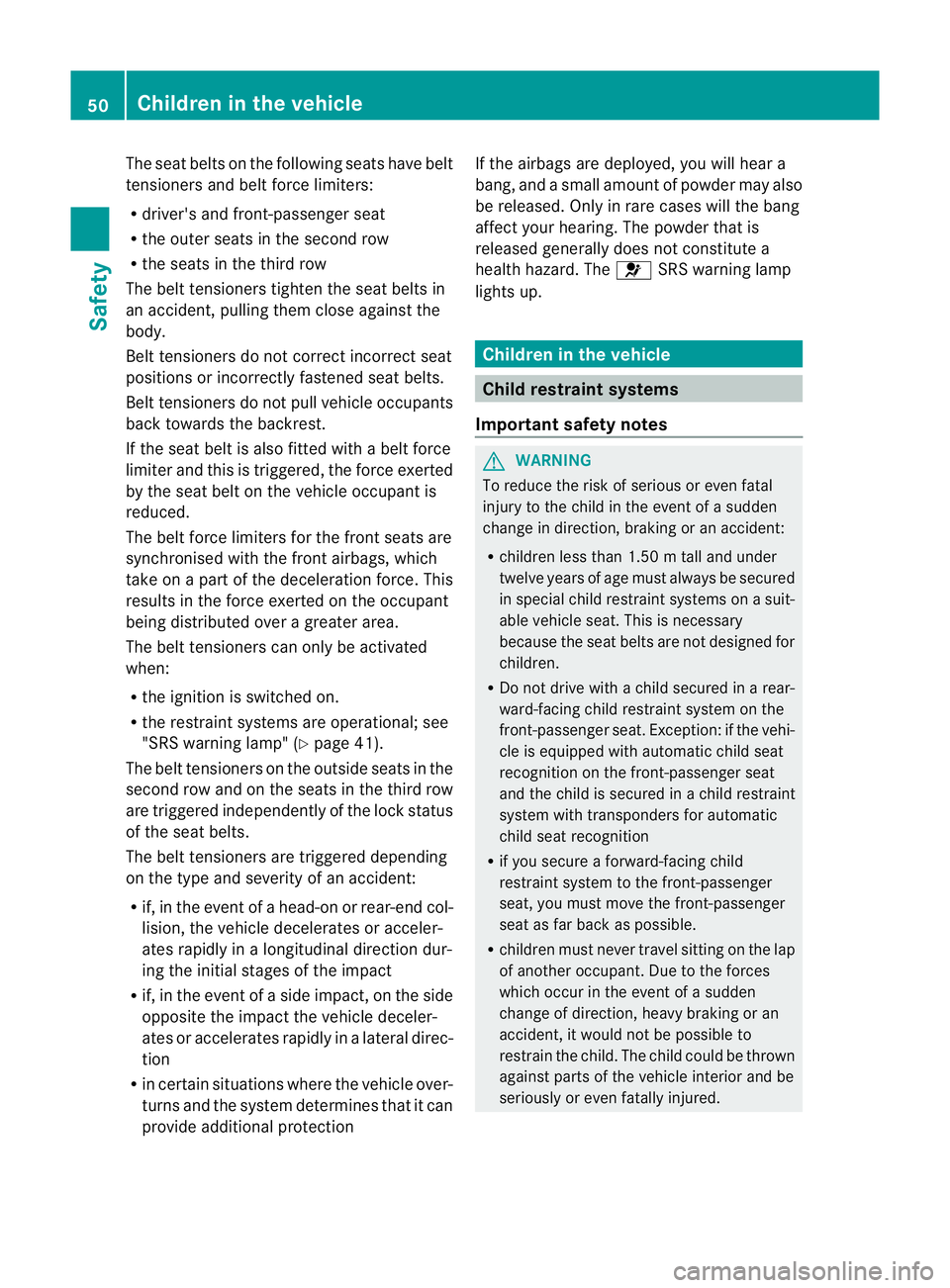
The seat belts on the following seats have belt
tensioner
sand bel tforc elimiters:
R driver's and front-passenger seat
R the outer seats in the second row
R the seats in the third row
The belt tensioners tighten the seat belts in
an accident ,pulling them close against the
body.
Belt tensioners do not correc tincorrect seat
positions or incorrectly fastened sea tbelts.
Belt tensioners do not pull vehicle occupants
back towards the backrest.
If the seat belt is also fit tedw ithabelt force
limiter and this is triggered, the force exer ted
by the seat belt on the vehicle occupant is
reduced.
The belt force limiters for the fron tseats are
synchronised with the fron tairbags, which
tak eona part of the deceleration force. This
result sinthe force exerted on the occupant
being distributed over agrea tera rea.
Th eb elt tensioners can only be activa ted
when:
R the ignition is switched on.
R the restraint system sare opera tional; see
"SR Swarnin glamp" (Y page 41).
The belt tensioners on the outside seats in the
second row and on the seats in the thir drow
ar et riggere dindependently of the lock status
of the sea tbelts.
The belt tensioners are triggere ddepending
on the type and severity of an accident:
R if, in the even tofahead-on or rear-end col-
lision, the vehicle decelerates or acceler-
ates rapidly in alongitudinal direction dur-
ing the initial stages of the impact
R if, in the even tofaside impact, on the side
opposit ethe impac tthe vehicle deceler-
ates or accelerates rapidly in alateral direc-
tion
R in certain situations where the vehicle over-
turns and the system determines that it can
provide additional protection If the airbags are deplo
yed,you will hear a
bang, and asmall amount of powder may also
be released. Only in rare cases will th ebang
affect your hearing. The powde rthat is
released generally does not constitute a
healt hhazard. The 6SRS warning lamp
lights up. Children in the vehicle
Child restraint systems
Important safety notes G
WARNING
To reduce the risk of serious or even fatal
injury to the child in the event of asudden
change in direction, braking or an accident:
R children less than 1.50 mtall and under
twelve years of age must always be secured
in special child restraint systems on asuit-
able vehicle seat. This is necessary
because the seat belts are not designed for
children.
R Do not drive with achild secured in arear-
ward-facing child restraint system on the
front-passenger seat. Exception: if the vehi-
cle is equipped with automatic child seat
recognition on the front-passenger seat
and the child is secured in achild restraint
system with transponders for automatic
chil dseat recognition
R if you secur eaforward-facing child
restraint system to the front-passenger
seat, you must mov ethe front-passenger
seat as fa rback as possible.
R children must never travel sitting on the lap
of another occupant. Due to the forces
which occur in the event of asudden
change of direction, heavy braking or an
accident, it would not be possible to
restrain the child. The child could be thrown
against parts of the vehicle interior and be
seriously or even fatally injured. 50
Children in the vehicleSafety
Page 54 of 441
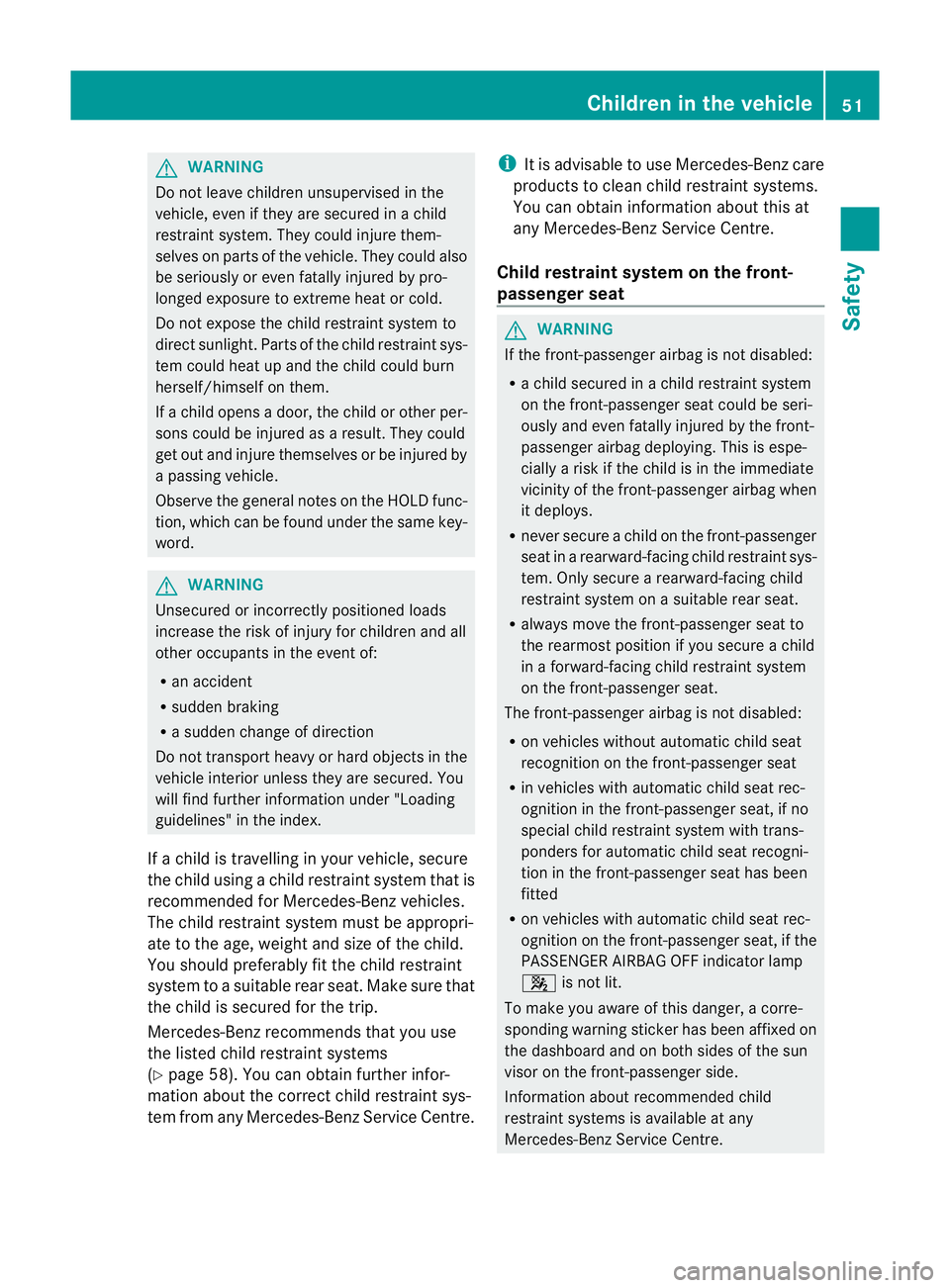
G
WARNING
Do not le avec hildren unsupervised in the
vehicle, even if they ar esecur edinac hild
restraint system .They could injur ethem-
selv eson parts of the vehicle. They could also
be seriously or even fatally injure dbypro-
longe dexpos uretoe xtreme hea torcold.
Do not expose the child restraint system to
direct sunlight. Part softhe chil drestraint sys-
tem could heat up and the child could burn
herself/himself on them.
If ac hild opens adoor, the child or other per-
sons coul dbeinjured as aresult. They could
get out and injure themselves or be injured by
ap assing vehicle.
Observe the general notes on the HOLD func-
tion, which can be found under the same key-
word. G
WARNING
Unsecured or incorrectly positioned loads
increase the risk of injury for children and all
other occupant sinthe even tof:
R an accident
R sudden braking
R as udden change of direction
Do not transpor theavy or hard objects in the
vehicle interior unless they are secured. You
will fin dfurther information under "Loading
guidelines" in the index.
If ac hild is travellin ginyour vehicle, secure
the child using achild restraint system that is
recommended for Mercedes-Ben zvehicles.
The child restraint system must be appropri-
ate to the age, weight and size of the child.
You should preferabl yfit the child restraint
system to asuitable rear seat. Make sure that
the child is secured for the trip.
Mercedes -Benz recommends that you use
the listed child restraint systems
(Y page 58). You can obtain further infor-
mation about the cor rect chil drestraint sys-
tem from any Mercedes-Benz Ser vice Centre. i
It is advisabl etou se Mercedes-Ben zcare
product stoclean child restraint systems.
You can obtain information about this at
any Mercedes-Benz Service Centre.
Child restraint system on the front-
passenger seat G
WAR
NING
If the front-passenge rairbag is not disabled:
R ac hild secured in achild rest raint system
on the front-passenger seat could be seri-
ously and even fatally injured by the front-
passenger airbag deploying. This is espe-
cially arisk if the child is in the immediate
vicinit yofthe front-passenger airbag when
it deploys.
R never secur eachild on the front-passenger
seat in arearward-facing child restraint sys-
tem. Only secur earearward-facing child
restraint system on asuitable rear seat.
R alway smove the front-passenger seat to
the rearmost position if you secur eachild
in af orward-facing child rest raint system
on the front-passenger seat.
The front-passenger airbag is not disabled:
R on vehicles without automatic child seat
recognition on the front-passenger seat
R in vehicles with automatic child seat rec-
ognition in the front-passenger seat, if no
special child restraint system with trans-
ponders for automatic child seat recogni-
tion in the front-passenger seat has been
fitted
R on vehicles with automatic child seat rec-
ognition on the front-passenger seat, if the
PASSENGER AIRB AGOFF indicator lamp
4 is not lit.
To make you aware of this danger, acorre-
spondin gwarning sticker has been affixed on
the dashboard and on both sides of the sun
visor on the front-passenger side.
Information about recommended child
restraint systems is available at any
Mercedes-Benz Service Centre. Children in th
evehicle
51Safety Z
Page 55 of 441
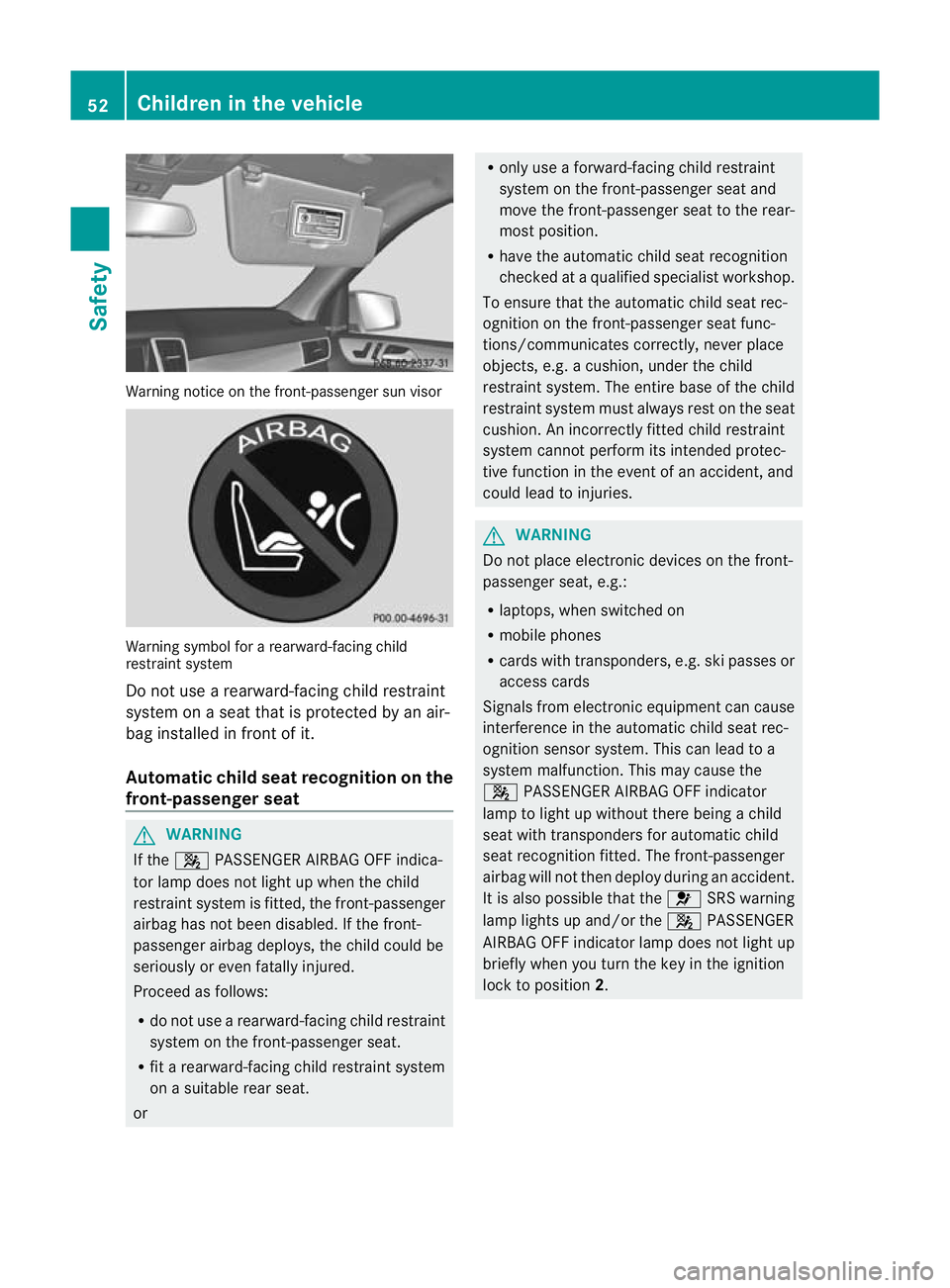
Warning notice on the front-passenger sun visor
Warning symbol for
arearward-facin gchild
rest raint system
Do not use arearward-facin gchild rest raint
system on aseat that is protected by an air-
bag installed in fron tofit.
Automatic chil dseat recognition on the
front-passenger seat G
WARNING
If the 4 PASSENGE RAIRBA GO FF indica-
tor lamp does not light up whe nthe child
restraint system is fitted, the fr ont-passenger
airbag has not been disabled. If the fr ont-
pa ssenger airbag deploys, the chil dcould be
seriou slyor even fatally injured.
Proceed as follows:
R do not use arearward-facin gchild restraint
system on the fr ont-passengers eat.
R fit arearward-facing child restraint system
on asuitable rear seat.
or R
only use aforward-facing child rest raint
system on the front-passenger seat and
move the front-passenger seat to the rear-
most position.
R have the automatic child seat recognition
checked at aqualified specialist workshop.
To ensure that the automatic child seat rec-
ognition on the front-passenger seat func-
tions/communicates correctly, never place
objects, e.g. acushion, under the child
restraint system. The entire base of the child
restraint system must alway srest on the seat
cushion. An incorrec tlyf itted child restraint
system cannot perfor mits intended protec-
tive function in the event of an accident, and
could lead to injuries. G
WARNING
Do not place electronic devices on the front-
passenger seat, e.g.:
R laptops, when switched on
R mobile phones
R cards with transponders, e.g. ski passes or
access cards
Signals from electronic equipment can cause
interference in the automatic child seat rec-
ognition sensor system. Thi scan lead to a
system malfunc tion. This may cause the
4 PASSENGER AIRBA GOFF indicator
lamp to light up without there being achild
seat with transponder sfor automatic child
seat recognition fit ted. The front-passenger
airba gwill not then deploy during an accident.
It is also possible that the 6SRS warning
lamp lights up and/or the 4PASSENGER
AIRB AGOFF indicator lam pdoes not light up
briefly when you tur nthe key in the ignition
lock to position 2.52
Children in th
evehicleSafety
Page 56 of 441
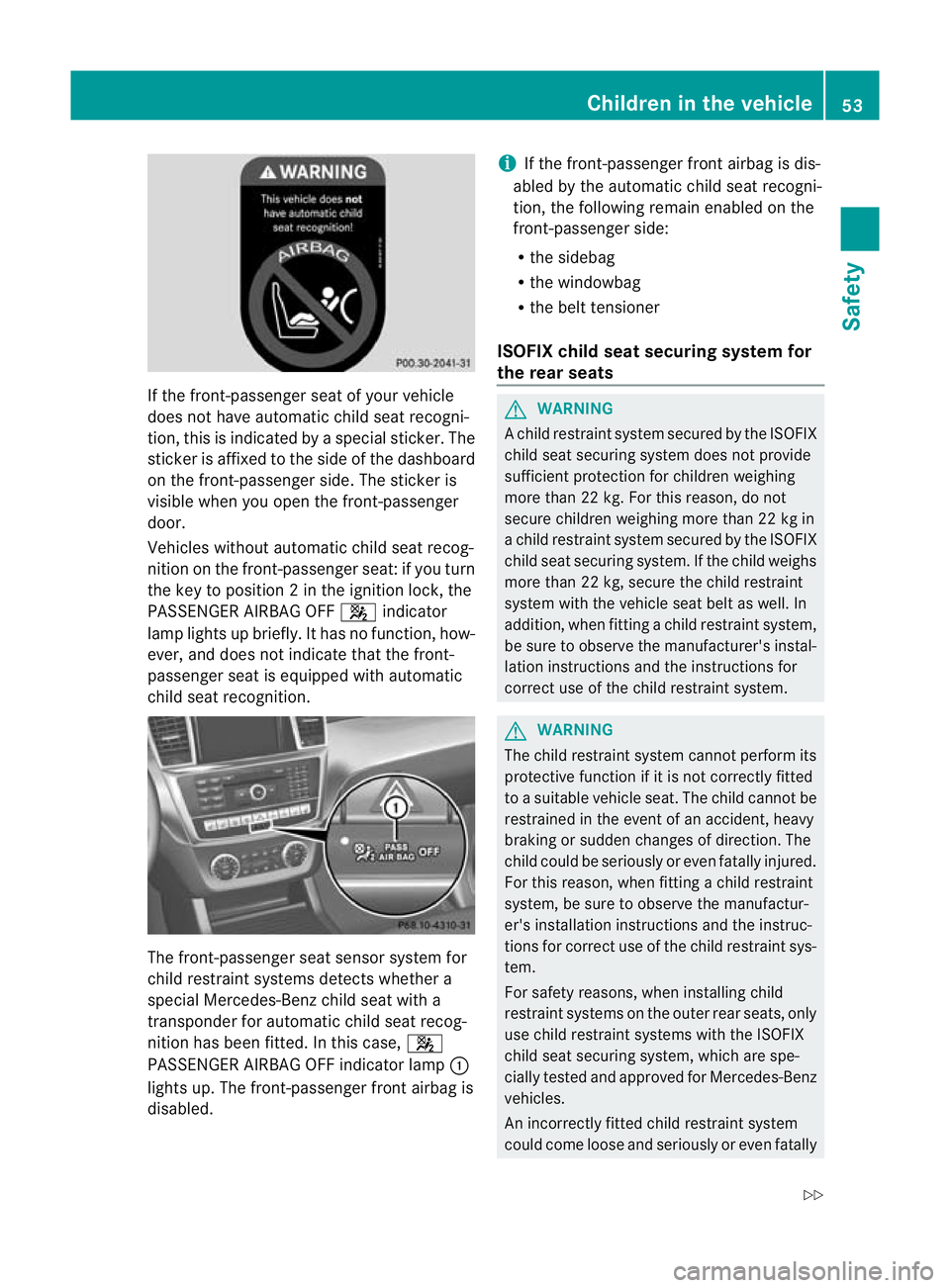
If th
efront-passenger seat of yo urvehicle
does no thave automatic child seat recogni-
tion, this is indicated by aspecial sticker. The
sticker is affixed to the side of the dashboard
on the front-passenger side. The sticker is
visible when you open the front-passenger
door.
Vehicles without automatic child seat recog-
nition on the front-passenger seat: if you turn
the key to position 2inthe ignition lock ,the
PAS SENG ER AIRBAG OFF 4indicator
lamp lights up briefly. It has no function, how-
ever, and doe snot indicate that the front-
passenger seat is equipped with automatic
child seat recognition. The front-passenger seat sensor system for
child restraint system
sdetect swhether a
special Mercedes-Ben zchild seat with a
transpo nder for automatic child seat recog-
nition has been fitted. In this case, 4
PASSENGER AIRBA GOFF indicato rlamp :
lights up. The front-passenger front airbag is
disabled. i
If the front-passenger front airbag is dis-
abled by the automatic child seat recogni-
tion, the following remain enabled on the
front-passenger side:
R the sidebag
R the windowbag
R the belt tensioner
ISOFI Xchilds eat securing system for
the rear seats G
WARNING
Ac hild restraint system secured by the ISOFIX
chil dseat securing system does not provide
sufficien tprotection for children weighing
more than 22 kg. For this reason, do not
secure children weighing more than 22 kg in
ac hild restraint system secured by the ISOFIX
chil dseat securing system. If the child weighs
mor ethan 22 kg, secur ethe chil drestraint
system with the vehicle seat belt as well. In
addition ,when fittin gachild restraint system,
be sur etoobservethe manufacturer' sinstal-
latio ninstructions and the instructions for
correct use of the child restraint system. G
WARNING
The child restraint system cannot perform its
protective function if it is not correctly fitted
to as uitable vehicle seat. The child cannot be
restrained in the event of an accident, heavy
braking or sudde nchanges of direction. The
chil dcould be seriously or even fatally injured.
For this reason, when fittin gachild restraint
system ,besure to observe the manufactur-
er's installatio ninstructions and the instruc-
tions for correct use of the child restraint sys-
tem.
For safety reasons, whe ninstalling child
restraint systems on the outer rear seats, only
use child restraint systems with the ISOFIX
child sea tsecuring system, which are spe-
ciall ytested and approved for Mercedes-Benz
vehicles.
An incorrectly fitted child restraint system
could com eloose and seriously or even fatally Children in the vehicle
53Safety
Z
Page 59 of 441
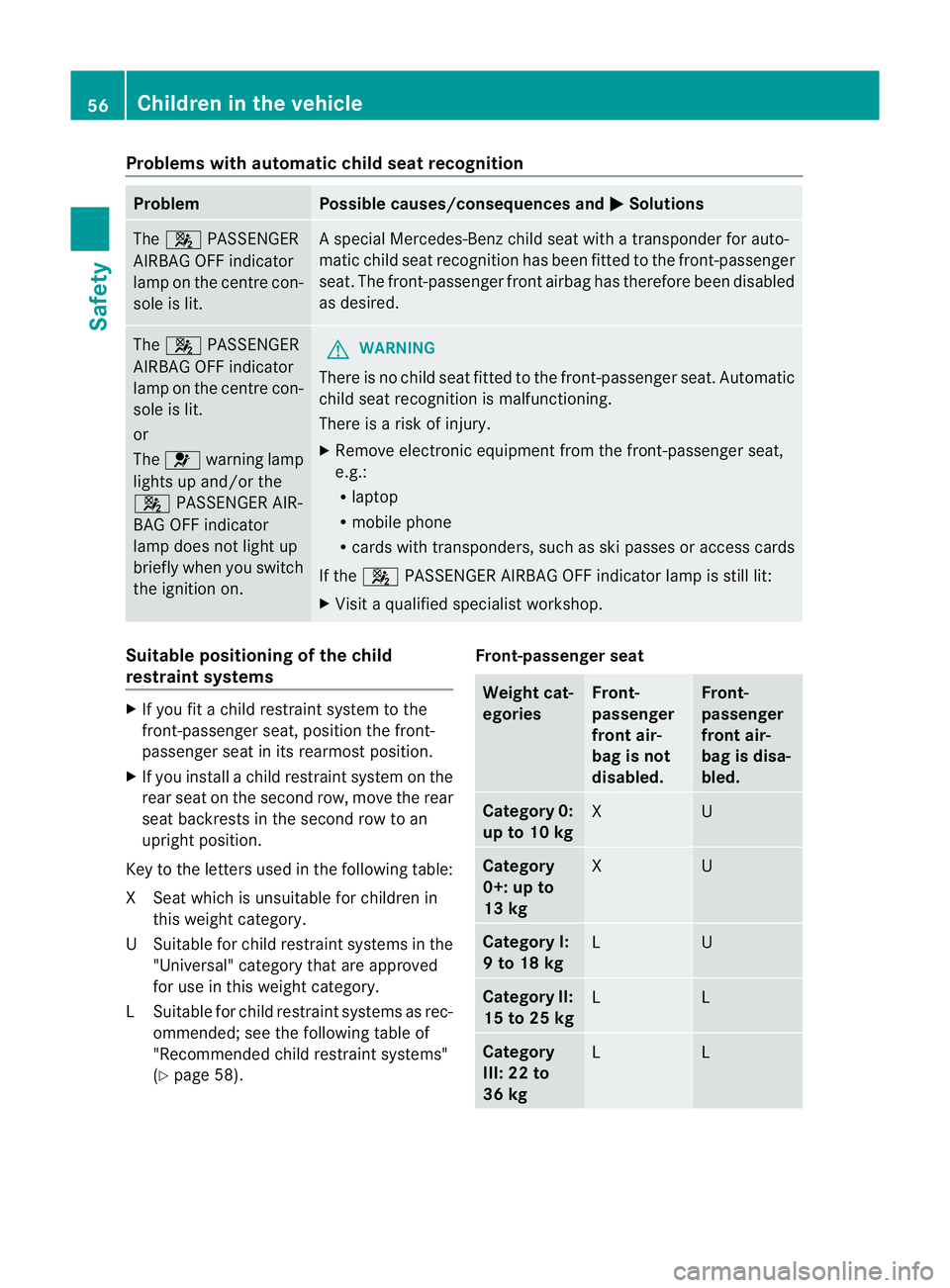
Problems wit
hautomatic chil dseat recognition Problem Possible causes/consequences and
M Solutions
The
4 PASSENGER
AIRB AGOFF indicator
lam ponthe cen trecon-
sole is lit. As
pecial Mercedes-Benz child seat with atransponde rfor auto-
matic child seat recognition has been fit tedtot he front-passenger
seat. The front-passenger fron tairbag has therefore been disabled
as desired. The
4 PASSENGER
AIRBA GOFF indi cator
lamp on the centr econ-
sole is lit.
or
The 6 warnin glamp
lights up and/or the
4 PASSENGER AIR-
BA GO FF indi cator
lamp doe snot light up
briefly when you switch
the ignition on. G
WARNING
There is no child seat fitted to the fr ont-passengerseat .Automatic
child seat recognition is malfunctioning.
There is arisk of injur y.
X Remove electronic equipment from the front-passenger seat,
e.g.:
R
laptop
R mobil ephone
R card switht ransponders, such as sk ipasses or accessc ards
If the 4 PASSENGER AIRBAG OFF indicator lamp is still lit:
X Vis itaq uali fieds pecialist workshop. Suitable positioning of the child
restraint syste
ms X
Ifyou fit achild restraint system to the
front-passenger seat, position the front-
passenger seat in its rearmos tposition.
X If you install achild rest raint system on the
rear seat on the second row, move the rear
seat backrest sinthe secon drow to an
upright position.
Key to the letters used in the following table:
XS eat which is unsuitable for children in
this weight category.
US uitable for child rest raint systems in the
"Universal" categor ythat ar eapproved
for use in this weigh tcategory.
LS uitable for child rest raint systems as rec-
ommended; see th efollowin gtable of
"Recommended child restraint systems"
(Y page 58). Front-passenger seat Weight cat-
egories Front-
passenger
front air-
bag is not
disabled. Front-
passenger
front air-
bag is disa-
bled.
Categor
y0:
up to 10 kg X U
Cate
gory
0+: up to
13 kg X U
Category I:
9to18kg
L U
Category II:
15 to 25 kg
L L
Category
III: 22 to
36 kg
L L56
Children in the vehicleSafety
Page 64 of 441
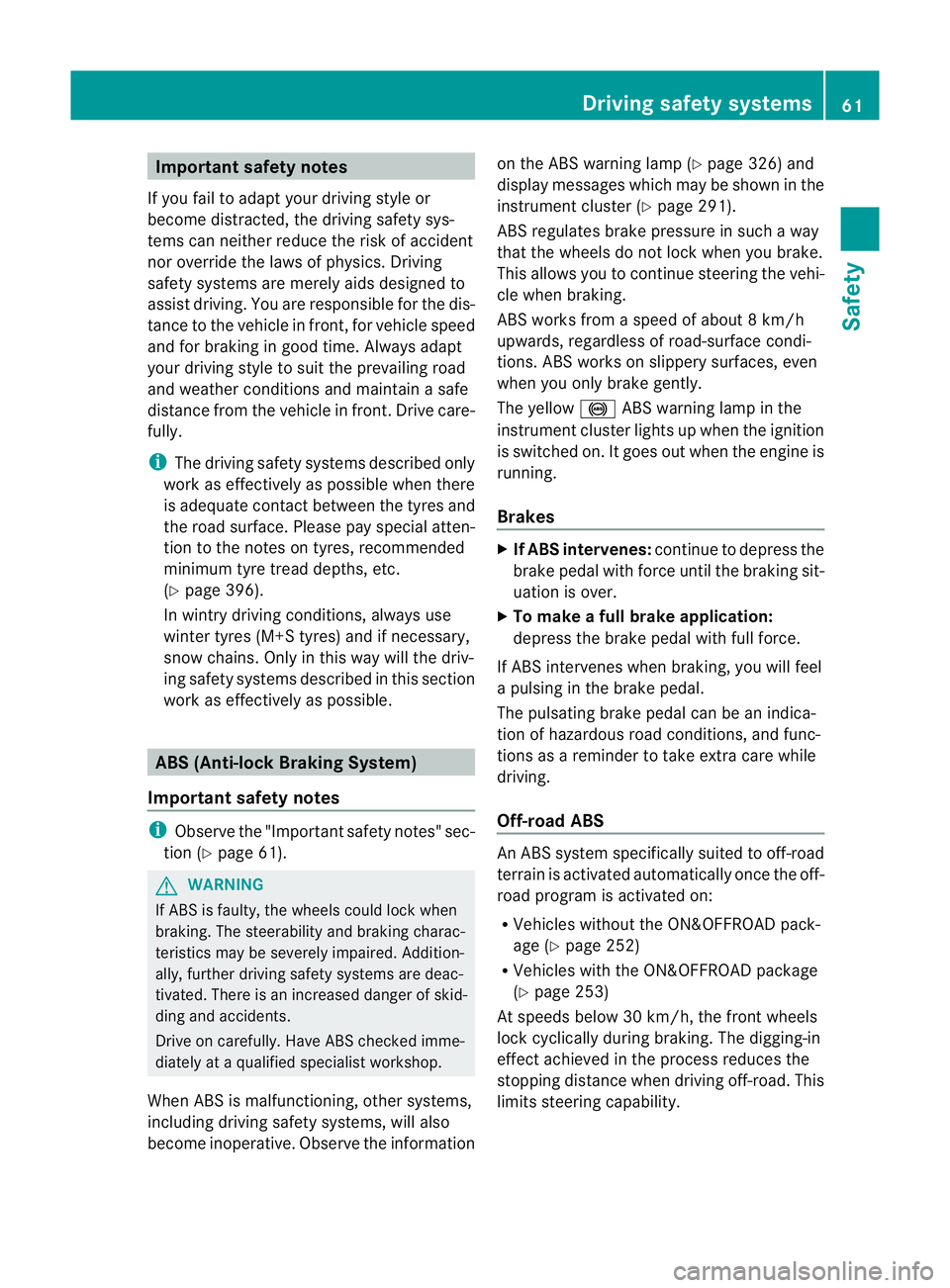
Important safety notes
If you fail to adapt your driving style or
become distracted, th edriving sa fetysys-
tems ca nneith er reduce th erisk of accident
no ro verri dethe law sofphysics. Driving
safety system sare mere ly aids desig nedto
assis tdrivi ng.You ar eresponsible for the dis-
tance to the vehicle in fr ont, forvehicle speed
and for braking in good time. Alway sadapt
your drivin gstyle to suit the prevailing road
and weather condition sand maintain asafe
distance from the vehicle in front .Drive care-
fully.
i Thed riving safet ysystems described only
work as effectively as possibl ewhen there
is adequate con tact betwee nthe tyres and
the roa dsurface. Pleas epay special atten-
tion to the notes on tyres, recommended
minimum tyre tread depths ,etc.
(Y page 396).
In wintry driving conditions, always use
winter tyres (M+S tyres) and if necessary,
snow chains .Only in this way will the driv-
ing safety systems described in this section
work as effectively as possible. ABS (Anti-lock Braking System)
Important safety notes i
Observe the "Important safety notes" sec-
tion (Y page61). G
WARNING
If ABS is faulty, the wheels could lock when
braking .The steerability and brakin gcharac-
teristics ma ybeseverely impaired. Addition-
ally, further driving safet ysystems are deac-
tivated. There is an increased danger of skid-
ding and accidents.
Drive on carefully. Have ABS checked imme-
diatel yata qualified specialist workshop.
When ABS is malfunctioning, other systems,
including driving safety systems, will also
become inoperative. Observe the infor mation on the ABS warning lamp (Y
page 326) and
display messages which may be shown in the
instrument cluster (Y page 291).
ABS regulate sbrake pressure in such away
that the wheels do not lock when you brake.
This allows you to continue steering the vehi-
cle when braking.
ABS works from aspeed of about 8km/h
upwards, regardless of road-surfac econdi-
tions. AB Sworksons lippery surfaces, even
when you only brake gently.
The yellow !ABS warnin glamp in the
instrument cluster lights up when the ignition
is switched on. It goes out when the engine is
running.
Brakes X
If ABS intervenes: continue to depress the
brake pedal with force until the braking sit-
uation is over.
X To mak eafull brake application:
depress th ebrake peda lwith full force.
If ABS intervenes when braking, you will feel
ap ulsing in the brake pedal.
The pulsating brake pedal can be an indica-
tion of hazardous road conditions, and func-
tions as areminder to take extr acare while
driving.
Off-road ABS An ABS system specifically suited to off-road
terrain is activated automatically once the off-
road program is activated on:
R
Vehicles without the ON&OFFROAD pack-
age (Y page 252)
R Vehicles with the ON&OFFROAD package
(Y page 253)
At speeds below 30 km/h, the front wheels
lock cyclically during braking. The digging-in
effect achieved in the process reduces the
stopping distance when driving off-road. This
limits steering capability. Driving safety systems
61Safety Z
Page 67 of 441
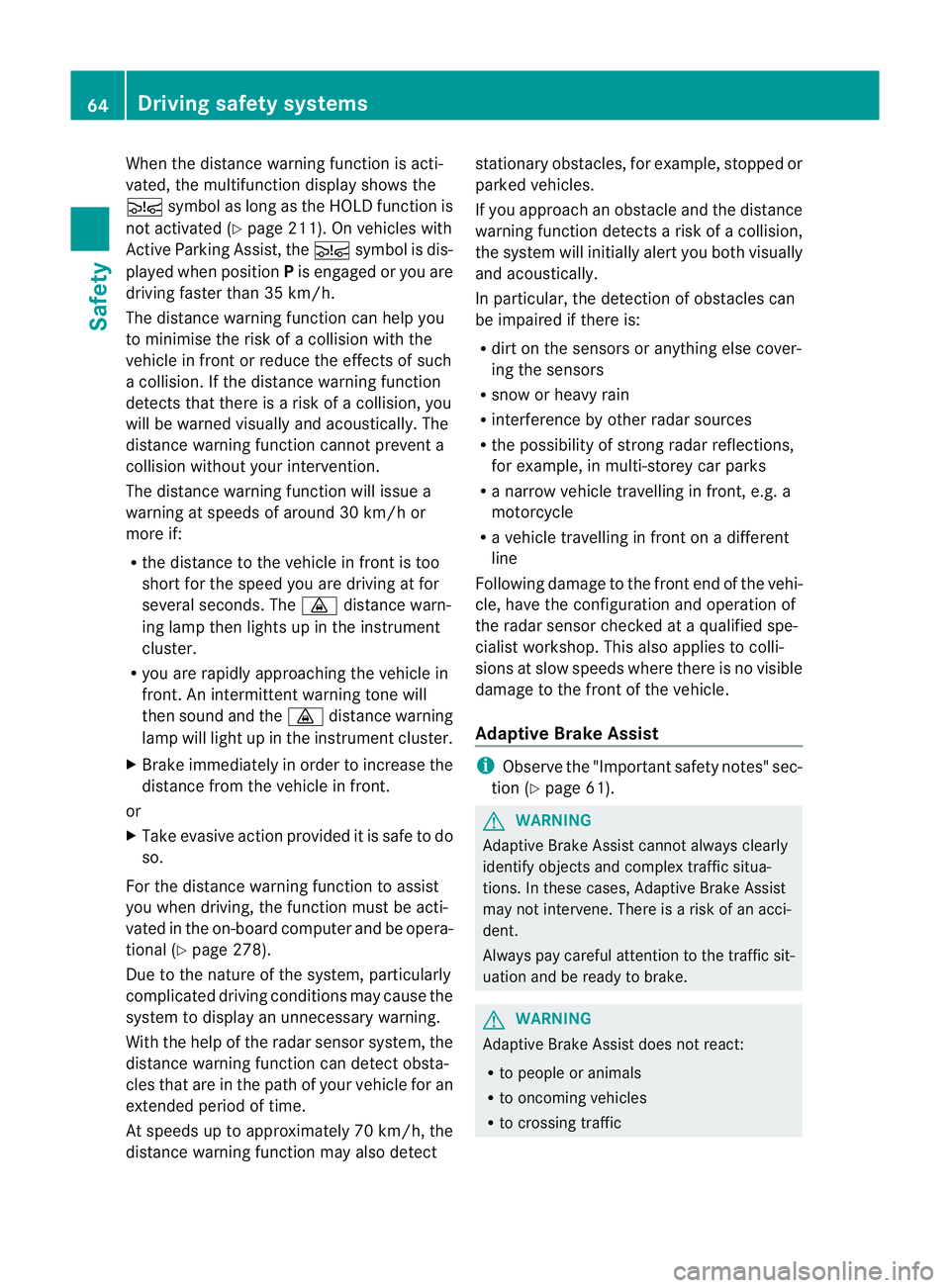
When the distan
cewarning function is acti-
vated, the multifunction display shows the
Ä symbol as long as the HOLD function is
not activated (Y page 211). On vehicles with
Active Parking Assist, the Äsymbol is dis-
played when position Pis engaged or you are
driving faster than 35 km/h.
The distanc ewarning function can help you
to minimise the risk of acollision with the
vehicle in fron torreduce the effects of such
ac ollision .Ifthe distanc ewarning function
detect sthat ther eisar isk of acollision ,you
will be warned visually and acoustically .The
distanc ewarning function cannot preven ta
collision without your inte rvention.
The distan cewarning function will issue a
warning at speed sofaround 30 km/h or
more if:
R thed istanc etothe vehicle in fron tist oo
short for the speed you ar edriving at for
severa lseconds. The ·distan cewarn-
ing lamp then lights up in the instrument
cluster.
R you are rapidly approaching the vehicle in
front. An intermittent warning ton ewill
then sound and the ·distanc ewarning
lamp will light up in the instrument cluster.
X Brak eimmediatel yinordertoi ncreas ethe
distanc efrom th evehicle in front.
or
X Take evasiv eactio nprovide ditiss afe to do
so.
For the distanc ewarning function to assist
you when driving, the function must be acti-
vated in the on-board computer and be opera-
tional (Y page 278).
Due to the nature of the system, particularly
complicated driving conditions may cause the
system to display an unnecessary warning.
With the help of the radar senso rsystem, the
distanc ewarning function can detect obsta-
cles that are in the path of your vehicle for an
extended period of time.
At speeds up to approximately 70 km/h, the
distance warning fun ction may also detect stationary obstacles, for example, stopped or
parked vehicles.
If you approach an obstacle and the distance
warnin gfunction detects arisk of acollision,
the system will initially aler tyou both visually
and acoustically.
In particular ,the detection of obstacles can
be impaired if ther eis:
R dir tont he sensors or anythin gelse cover-
ing the sensors
R snow or heavy rain
R interferenc ebyother radar sources
R the possibility of strong radar reflections,
for example, in multi-storey car parks
R an arro wvehicle travelling in front, e.g. a
motorcycle
R av ehicle travelling in fron tonadifferent
line
Following damage to the fron tend of the vehi-
cle ,havet he configuration and operation of
the radar sensor checked at aqualified spe-
cialist workshop. This also applie stoc olli-
sions at slow speeds where ther eisnovisible
damage to the fron tofthe vehicle.
Adaptive Brake Assist i
Observ ethe "Importan tsafety notes" sec-
tion (Y page 61). G
WARNING
Adaptive Brake Assist cannot always clearly
identify objects and complex traffic situa-
tions. In these cases, Adaptive Brake Assist
may not intervene. There is arisk of an acci-
dent.
Always pay careful attention to the traffic sit-
uation and be ready to brake. G
WARNING
Adaptive Brak eAssist does not react:
R to people or animals
R to oncomi ng vehicles
R to crossing traffic 64
Driving safety systemsSafety
Page 68 of 441
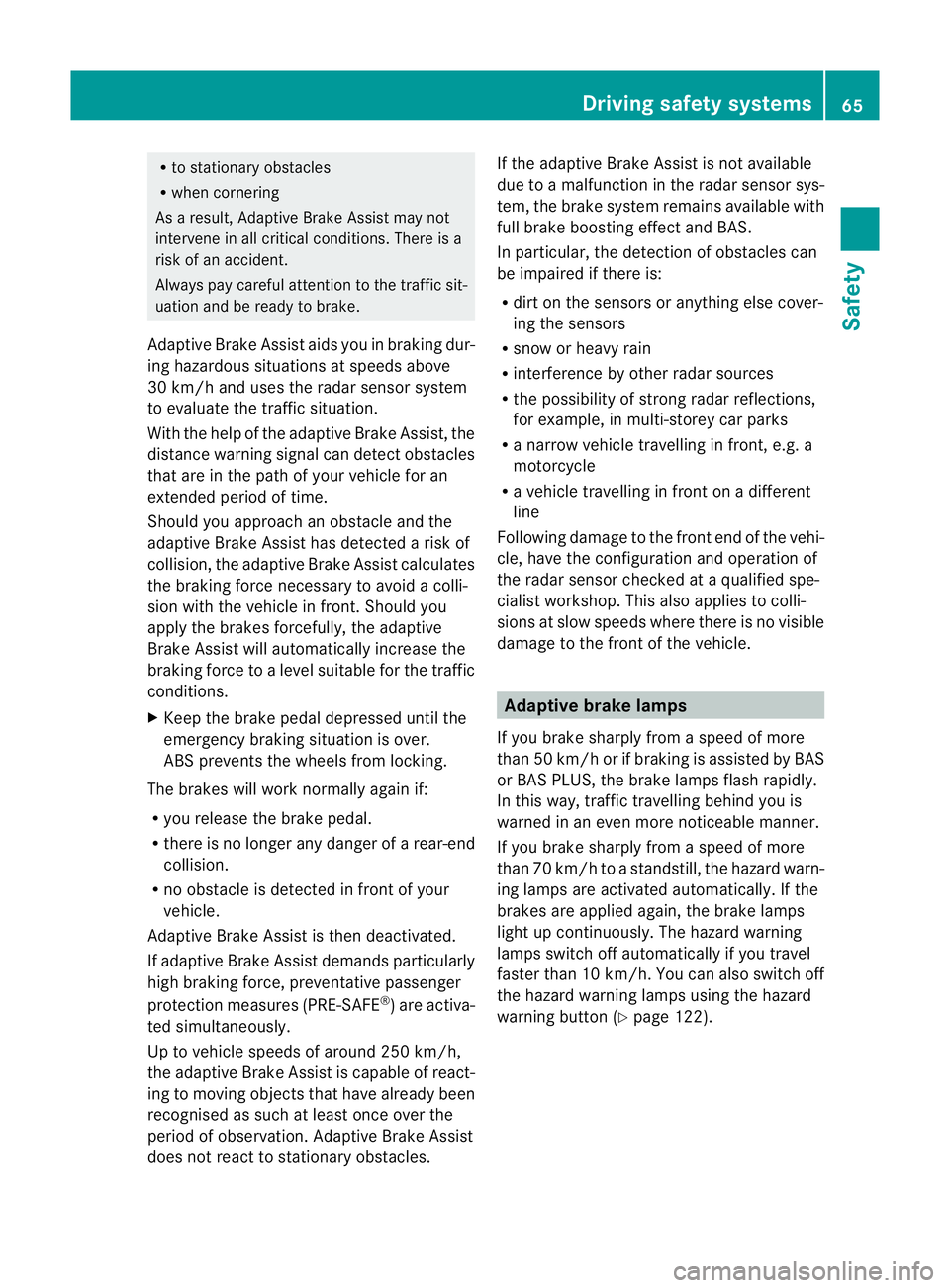
R
to stationary obstacles
R when cornering
As aresult, Adaptive Br akeA ssist may not
int ervene in al lcritica lconditions .There is a
risk of an accident.
Always pay carefu lattention to the traffic sit-
uation and be ready to brake.
Adaptive Brake Assist aids you in braking dur-
ing hazardous situations at speeds above
30 km/h and uses the radar sensor system
to evaluate the traffic situation.
With the hel pofthe adaptive Brake Assist ,the
distanc ewarning signal can detect obstacles
that are in the path of your vehicle for an
extended period of time.
Should you approach an obstacle and the
adaptive Brake Assis thas detected arisk of
collision, the adaptive Brake Assist calculates
the brakin gforc enecessar ytoavoidac olli-
sion with the vehicle in front .Should you
apply the brakes forcefully ,the adaptive
Brake Assist will automatically increase the
brakin gforc etoal evel suitable for the traffic
conditions.
X Keep the brak epedal depressed until the
emergency braking situation is over.
ABS prevents the wheels from locking.
The brakes will work normally again if:
R you release the brak epedal.
R there is no longer any danger of arear-end
collision.
R no obstacl eisdetected in front of your
vehicle.
Adaptive Brake Assist is then deactivated.
If adaptive Brake Assist demands particularly
high braking force, preventative passenger
protec tion measure s(PRE-SAFE ®
)a re activa-
ted simultaneousl y.
Up to vehicl espeeds of around 25 0km/h,
th ea daptiv eBrake Assist is capable of react-
ing to moving objects that have alread ybeen
recognised as such at least once over the
period of observation .Adaptiv eBrake Assist
does not react to stationary obstacles. If th
eadaptiv eBrake Assist is not available
du et oam alfunction in the radar senso rsys-
tem, the brake syste mremains available with
ful lbrake boostin geffect and BAS.
In particular, th edetection of obstacles can
be impaired if there is:
R dirt on the sensors or anything else cover-
ing the sensors
R snow or heavy rain
R interference by other rada rsources
R the possibility of stron gradar reflections,
for example, in multi-storey car parks
R an arrow vehicle travelling in front ,e.g. a
motorcycle
R av ehicle travelling in front on adifferent
line
Following damage to the front end of the vehi-
cle, have the configuration and operation of
the radar sensor checked at aqualified spe-
cialist workshop. This also applies to colli-
sions at slow speeds where there is no visible
damage to the front of the vehicle. Adaptive brake lamps
If you brake sharply from aspeed of more
than 50 km/ horifbraking is assisted by BAS
or BAS PLUS, th ebrake lamp sflash rapidly.
In this way, traffic travelling behind you is
warned in an even more noticeable manner.
If you brake sharply from aspeed of more
than 70 km/ htoastandstill, the hazard warn-
ing lamps are activated automatically .Ifthe
brakes ar eapplied again, the brak elamps
light up continuously .The hazard warning
lamps switc hoff automatically if you travel
faster than 10 km/h .You can also switc hoff
th eh azard warning lamps using the hazard
warning button (Y page 122). Driving safety systems
65Safety Z